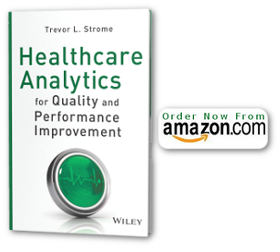 The Challenge – Increasing Need for Actionable Insight.
The Challenge – Increasing Need for Actionable Insight.
Healthcare transformation efforts require decision makers to use information to understand all aspects of an organization’s performance. In addition to knowing what has happened, decision makers now require insight into what is likely going to happen, what the improvement priorities of the organization should be, and what the anticipated impacts of process and other improvements will be.
Simply proliferating dashboards, reports, and fancy visualizations to accommodate ever-growing volumes of health data is not enough to provide the insight that decision makers need. Analytics, on the other hand, can help healthcare organizations achieve understanding and insight of their quality and operational performance by transforming the way information is used and decisions are made throughout the organization.
The Solution – Healthcare Analytics
As I mention in my book Healthcare Analytics for Quality and Performance Improvement, analytics is the system of tools and techniques required to generate insight from data. The effective use of analytics within a healthcare organization requires that the necessary tools, techniques, and systems have been applied appropriately and consistently, and that the information and insight generated by analytics is accurate, validated, and trustworthy.
Improving Decision-Making
In modern healthcare, substantial quality and performance improvement may be stymied without changes to the way information is used and acted upon. With this in mind, the fundamental objective of healthcare analytics is to “help people to make and execute rational decisions, defined as being data driven, transparent, verifiable and robust”:1
- Data driven. Modern healthcare standards demand that clinical decisions be based on the best possible evidence that is generated from extensive research and data. Yet administrative decisions, process and workflow design, healthcare information technology (such as electronic medical records), and even some clinical decisions are often not held to these standards. Analytics in healthcare can help ensure that all decisions are made based on the best possible evidence derived from accurate and verified sources of information rather than gut instinct or because a process or procedure has always been done that way.
- Transparent. Information silos are still a reality in healthcare due to the belief by some that withholding information from other departments or programs best maintains autonomy and control. This belief, however, often has the opposite effect and invariably leads to misunderstandings and a deterioration of trust. Another objective of analytics in healthcare is to promote the sharing of information and to ensure that the insight and information is clearly defined and consistently interpreted throughout the HCO.
- Verifiable. Consistent and verifiable decision making involves a validated decision-making model that links the proposed options from which to choose to the decision criteria and associated methodology for selecting the best available option. With this approach, the selected option “can be verified, based on the data, to be as good as or better than other alternatives brought up in the model.”2
- Robust. Because healthcare is a dynamic environment, decisions must often be made quickly and without perfect data on which to base them. Decision-making models must be robust enough to perform in nonoptimal conditions. That is, they must accommodate biases that might be introduced as a result of missing data, calculation errors, failure to consider all available options, and other issues. Robust models can benefit from a feedback loop in which improvements to the model are made based on its observed performance.
Next Steps
In the last several years, healthcare organizations have made great strides in making information available to decision-makers via numerous reports, dashboards, and other data tools. Roadblocks to improved decision-making still exist, however. These roadblocks include issues such as poor “numerical literacy” among healthcare managers and other decision makers, inappropriate visualization and analysis of available data, and flawed decision-making models and processes. Future posts on this blog will focus on identifying these roadblocks, and how to manage and/or eliminate them from your healthcare organization.
References:
1, 2. Rahul Saxena and Anand Srinivasan, Business Analytics: A Practitioner’s Guide, International Series in Operations Research & Management (New York: Springer Science+Business Media, 2013).
Note:
This post is based on an excerpt taken from Chapter 2 of my book, Healthcare Analytics for Quality and Performance Improvement published by John Wiley & Sons, Inc. For a limited time, you can download Chapter 2 for free using this link: Healthcare Analytics Chapter 2

{ 0 comments… add one now }